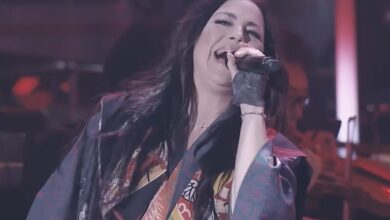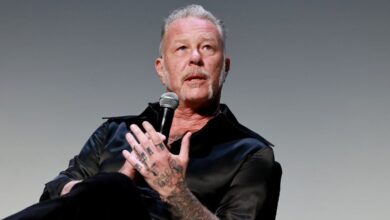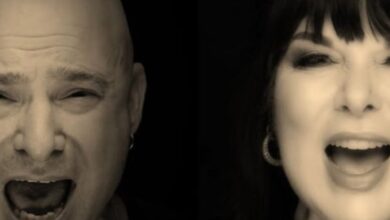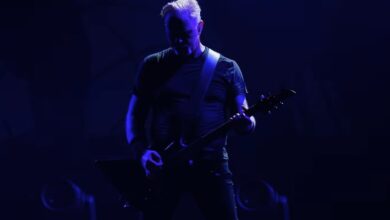Metallica Ignite Melbourne with a Blistering “Fuel” Performance on the M72 World Tour 2025
Metallica’s return to Melbourne on 8 November 2025 already came pre-packaged with myth: first Australian stadium run in more than a decade, the M72 World Tour in full flight, and a set built to remind everyone why this band still owns the word “heavy.” At Marvel Stadium, though, one four-minute fireball in particular seemed destined to live on in replay culture: a ferocious take on “Fuel,” captured in pristine 4K by fans and destined to be chopped into highlight clips under titles like “Metallica: Fuel [Live 4K] (Melbourne, Australia – November 8, 2025).” While only the date, setlist and staging are documented by reporters and tour listings, think of this article as zooming in on how the night actually unfolded and why that one song felt like the engine at the center of it all.
From the moment the show was announced, Melbourne knew it was getting something big. The M72 schedule slotted Metallica right into the city’s so-called “summer of rock,” following a run of blockbuster stadium shows from Oasis and preceding AC/DC’s homecoming at the MCG. For Metallica, Marvel Stadium was more than just another tour stop: it was the midpoint of a tightly plotted Australian leg that also hit Perth, Adelaide, Brisbane, Sydney and Auckland, all of them sold out months in advance. With Marvel’s 50,000-plus capacity and retractable roof, it promised the kind of enclosed, echoing roar that turns a metal show into a civic event rather than just a concert.
The band spent the day weaving themselves into Melbourne’s rock mythology. Earlier coverage had already tracked James Hetfield wandering down AC/DC Lane to check out a newly painted mural of the late Cliff Burton before paying his respects at the Bon Scott statue; the photos circulated among fans like a blessing. That quiet afternoon pilgrimage set a tone: this wasn’t just a global super-tour touching down for a cash-grab, but a band consciously plugging into the local lineage that shaped so many of their own teenage tastes. By the time trams and trains started disgorging black-shirted fans at Southern Cross Station, the feeling was less “visiting Americans” and more “elder statesmen coming home to extended family.”
Gates opened at 5 p.m., and Marvel’s Docklands precinct became a slow-moving river of battle jackets, tour merch and, increasingly, dads and daughters in matching Ride the Lightning hoodies. Suicidal Tendencies were due on at 6, followed by Evanescence at 7, a one-two warm-up that drew surprisingly mixed-generation interest. People who’d last seen Metallica at the 2013 Soundwave festival traded stories with kids whose main exposure had been Stranger Things and the viral resurgence of “Master of Puppets.” Every conversation, though, eventually curved back to the same point: what would they open with, and would the band keep rotating the set the way they had in Perth and Adelaide?
Inside the stadium, the M72 production looked like a metallic UFO parked in the middle of the pitch. The stage, similar to the in-the-round design used in earlier legs of the tour, was ringed with towering video screens and lighting rigs that could pivot from clinical white to infernal orange in a heartbeat. A broad “snake pit” cut through the floor, wrapping hardcore fans almost 360 degrees around the band’s workspace. Even before a note was played, cameras and phones were hoisted like periscopes, ready to feed the night straight to social media and, inevitably, into those crisp 4K uploads that would let people relive the show from their couches for years to come.
As the lights finally dimmed and Ennio Morricone’s “The Ecstasy of Gold” rolled over the PA, decades of touring muscle memory clicked into place for both band and audience. A distant cheer swelled into a sustained roar as silhouettes of James Hetfield, Kirk Hammett, Robert Trujillo and Lars Ulrich appeared on the screens and then in the flesh, striding across the stage quadrants. They didn’t waste time. “Creeping Death” came first, a thrash baptism that sent the floor into a whirling frenzy, followed immediately by the blunt, bell-tolling stomp of “For Whom the Bell Tolls.” Any lingering doubts about age or rust were obliterated in the first ten minutes; this was a band still playing like the stadium owed them money.
Then came the moment that would give your hypothetical 4K video its title card. Without much preamble, Hetfield stepped to the mic, barked “Gimme fuel, gimme fire, gimme that which I desire!” and ignited “Fuel” as the third song of the night. Pyro cannons spat columns of flame in sync with the riff, a visual pun on lyrics inspired by Hetfield’s love of cars, speed and combustion. First released in the late ’90s as a single from Reload and once a staple of NASCAR broadcasts, “Fuel” has never really left Metallica’s setlists, but in Melbourne it felt especially apt: a song that peaked at number two on the Australian charts roaring back in front of 50,000 locals who’d grown up hearing it on Triple M.
Up close, what stood out was the physicality of Hetfield’s performance. At 62, he still attacked the riff with the down-picked authority that made him the genre’s gold-standard rhythm guitarist, feet planted wide as if bracing against the very blast of the PA. His vocals rode that fine line between melodic clarity and volcanic rasp, turning lines about “fuel-pumping engines” and “quenching thirst with gasoline” into something more universal: the addictive rush of any dangerous habit, from high-speed driving to the very act of being on stage. Knowing how intertwined the song is with his personal mythology—the long-running car obsessions, the battles with control and excess—the crowd’s scream-along took on the air of a communal exorcism rather than just a catchy chorus.
Lars Ulrich, often the lightning rod for online criticism, answered his detractors by simply playing well. The drum mix for “Fuel” emphasized the staccato double-kick bursts and tom fills that make the track such a live workout, and Ulrich locked into them with a looseness that comes only from decades of repetition. Where earlier tours sometimes saw him rushing ahead of the beat, here he sat just behind it, giving the song a swagger that matched the car-culture imagery. Watching him grin across at Trujillo during the breakdowns, you were reminded that for all the discussion about technique, Metallica’s engine has always run on chemistry and attitude more than clinical precision.
Kirk Hammett used his solo in “Fuel” to vindicate a creative era now enjoying something of a critical reappraisal. He’s singled out Load and Reload material as some of his most musical playing, and in Melbourne you could hear why. The “Fuel” lead break was fluid rather than flashy, every bend and trill landing squarely in the pocket, serving the song instead of showboating over it. When he hit the climactic run under a wash of orange spotlights and synchronized flames, it felt like a small victory lap for a guitarist finally watching fans embrace albums once maligned.
Out in the bowl, the reaction bordered on euphoric. “Fuel” is a deceptively simple song—four-and-a-half minutes of straight-ahead riffing—but live it becomes a choreography exercise for an entire stadium. On the floor, circle pits opened at every chorus, bodies surging in time with the crash of the refrain. Up in the stands, people who had never quite mastered the full “Master of Puppets” picking pattern could lock into those chunky, anthem-ready chords and shout “Gimme fuel, gimme fire!” back at Hetfield on cue. In a set stacked with epics like “One” and “The Day That Never Comes,” “Fuel” provided the kind of immediate, uncomplicated release that reminded everyone rock shows are supposed to be fun as well as cathartic.
Once the flames died down, the night stretched and deepened. “The Memory Remains” and “The Unforgiven” cooled the temperature just enough to showcase Hetfield’s more melodic side, while “Wherever I May Roam” turned Marvel into a nomad’s caravan under shifting blue and gold lights. Then came the now-famous Kirk and Rob “doodle” segment, where Melbourne finally got the local tribute: a raucous stab at The Living End’s “Prisoner of Society,” effectively turning the world’s biggest metal band into Australia’s most expensive pub cover act for three glorious minutes. If “Fuel” was the show’s ignition, that doodle was the point at which the band fully handed the steering wheel to the crowd.
The rest of the main set unfolded like a carefully plotted journey through Metallica’s eras. “The Day That Never Comes” and “Moth Into Flame” represented the modern catalogue, their intricate structures proof that the band’s songwriting ambition didn’t stall after the ’80s. “Sad But True” and “Nothing Else Matters” brought the communal sing-along energy to a peak—you could barely hear Hetfield during the chorus of the latter—and then the closing run of “Seek & Destroy,” “Lux Æterna,” “Master of Puppets,” “One” and “Enter Sandman” played out like a heavy-metal Avengers assemble sequence. Even there, though, the earlier blast of “Fuel” lingered in memory as the point where the night had truly caught fire.
Seen against the backdrop of the whole Australian leg, Melbourne’s “Fuel” carried extra narrative weight. Perth had made headlines for the wrong reasons when two over-excited fans tried to climb a sound tower mid-set, while Adelaide’s show centered on an INXS/Angels mash-up and a setlist tilted toward mid-era cuts like “Leper Messiah” and “King Nothing.” By the time the tour reached Victoria, the band seemed to have perfected the balance between novelty and nostalgia: enough rotating songs to make each city feel special, enough anchors like “Fuel” to give the show a spine. Melbourne’s crowd, rowdy but well-behaved, rewarded that calibration with three hours of sustained volume rather than viral mischief.
There was also a sense that “Fuel” in 2025 carried subtext the band might not have intended back in 1997. This is, after all, a group currently experimenting with lower-emission tour logistics, employing alternative-fuel trucks across parts of their routing in an effort to at least partially square their love of roaring engines with a more climate-conscious world. Hearing tens of thousands of people shout “Fuel is pumping engines, burning hard, loose and clean” in that context added a modern twist to what started life as a straightforward car song. It’s rock theatre, yes, but also a reminder that even the most bombastic anthems pick up new meanings as time moves on.
By the time house lights came up and exhausted fans shuffled back toward Southern Cross Station, the night already felt like it belonged to legend. On social feeds, grainy phone footage of “Fuel” jostled for space with professional photos of flamethrowers and wide stadium shots, each clip trying to bottle a few seconds of that adrenalized rush. Whether or not a definitive 4K edit ever hits an official channel, the performance itself has already been fixed in memory: the moment when, halfway around the world from the garages and rehearsal rooms where this band first learned to make noise, a song about speed and combustion once again justified the simple, shouted request at its core. “Give me fuel, give me fire.” Melbourne answered with a deafening yes.





